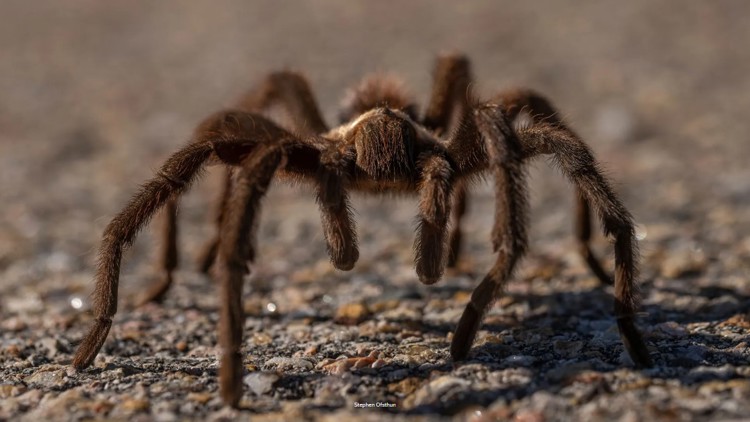OKLAHOMA, USA — Brown tarantulas can be found all across the South, including in Texas, Missouri, Kansas, Arkansas, and Louisiana. Now that it's mating season, they may be easier to find.
September typically marks the beginning of the mating season for brown tarantulas.
According to the Oklahoma Department of Wildlife Conservation (ODWC), the brown tarantula is one of 30 species of tarantulas found in the United States and one of 800 species documented worldwide.
"The tarantula is not a typical web spinner; they do not weave aerial webs to trap prey. Instead, they burrow into the ground to make a home for themselves, and they line their home with webbing to prey on grasshoppers, crickets, and other similar insects," ODWC said.
The tarantula, described by ODWC as a hunting spider, hunts at night, lining the entrance of its burrow with silk that serves as an alarm system for predators.
For many humans though, the tarantula's look is defensive enough.
"That scary look has created a fairly common phobia of the tarantula for many people," ODWC said.
While the large hairy arachnids may fend off humans with their appearance, the brown tarantula is considered a mostly passive creature.
However, if provoked, a brown tarantula may stand on its back legs and show its fangs to try to intimidate whatever is threatening it, ODWC said, adding that the spider has venom toxic to small animals but not usually life-threatening to humans.
"The next time you see a tarantula in Oklahoma, be assured that you probably scare it more than it should scare you. And if you are asked what to call the tarantulas around here, it's the Oklahoma brown tarantula," ODWC said.
The spider can weigh one to three ounces when fully grown and can have a leg span of four to five inches. They generally live in dry, desert regions but can also live in damp forests.
The brown tarantulas that make Oklahoma and Arkansas home will likely find shelter near small rocks and logs they can burrow underneath.
Occasionally, tarantulas will find their way into the human world, being spotted on roadways or near houses.
Beginning around September each year, male tarantulas migrate in search of a mate, and that's usually when they can be spotted in areas populated by people.
The migration marks just one moment in a male tarantula's typical one-year lifetime, but some females can survive up to three decades.
Once mated, female tarantulas line the walls of their burrows with eggs and stay close until they hatch.
ODWC said young tarantulas will molt several times as they grow, shedding and leaving behind their exoskeletons. Older tarantulas might molt once every two years. After molting, the spiders sport a new coat of camouflage, multiple shades of brown and tan on their bodies.
The hair on tarantulas is more than decorative.
The brown hairs act as a defense mechanism against predators such as snakes, coyotes, foxes, and birds, according to ODWC. The hairs can trigger an allergic reaction in attacks, creating an itchy effect.
Watch 5NEWS on YouTube.
Download the 5NEWS app on your smartphone:
Stream 5NEWS 24/7 on the 5+ app: How to watch the 5+ app on your streaming device
To report a typo or grammatical error, please email KFSMDigitalTeam@tegna.com and detail which story you're referring to.



